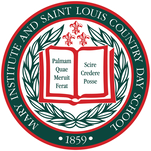STLinSTL 2021
STLinSTL Overview
Created and hosted by Mary Institute and Saint Louis Country Day School (MICDS), the Summit for Transformative Learning in St. Louis (STLinSTL) brings together experts and master teachers to share research-based, sustainable learning practices. STLinSTL seeks to prepare educators to create meaningful changes in their practice in order to meet the needs of today's learners. STLinSTL distinguishes itself from most conferences by offering experts in small classroom settings instead of larger auditorium venues. Learning for participants is student-centered, social, and personalized. One participant noted:
"This is the only conference where every session gives me ideas and pushes my thinking and the only one where speakers interact and
learn right along with us. Despite the big names, my sessions were never bigger than 30 and Jay McTighe even called me by name."
Educator, Woodward Academy
"This is the only conference where every session gives me ideas and pushes my thinking and the only one where speakers interact and
learn right along with us. Despite the big names, my sessions were never bigger than 30 and Jay McTighe even called me by name."
Educator, Woodward Academy
Conference ThemE
The overarching theme of STLinSTL 2025 is Designing Learning with Students at the Center. Students must be at the center of all learning. In creating curriculum, we must consider what the future will look like and what skills students will need to meet it with confidence and competence. In order to design contemporary learning experiences, teachers must honor tried and true teaching methods, keep abreast of emerging research-based best practices, be adept at Social and Emotional Learning, and understand the research of Mind, Brain, and Education Science. On top of all of this, Artificial Intelligence (ai) and other emerging and existing technologies need to be carefully considered and embedded into the student experience. It is a complex job that requires ongoing professional learning. STLinSTL strives to bring together classroom educators and respected experts in order to help teachers develop and grow the skills necessary to meet the challenges of teaching with students at the center.
The conference featured topics in several categories:
Schools of the Future
The "Schools of the Future" strand is designed to explore the cutting-edge innovations and transformative practices shaping the educational landscape. This strand will delve into forward-thinking pedagogies, emerging educational technologies, and the integration of artificial intelligence in classrooms. Participants will engage with thought leaders and practitioners redefining what it means to teach and learn in the 21st century.
Knowing and Valuing Students
The "Knowing and Valuing Students" strand focuses on the holistic development of students by emphasizing the importance of social-emotional learning (SEL), diversity, equity, inclusion, and belonging (DEIB), student wellness, and the power of relationships. This strand aims to equip educators with strategies and insights to create nurturing environments where every student feels seen, heard, and valued.
Student-Centered Best Practices - Elevating Through Engagement and Empowerment
The "Student-Centered Best Practices" strand is dedicated to refining and enhancing educational approaches that place students at the heart of the learning process. This strand will explore assessment and pedagogical best practices, strategies for maintaining a student-centered classroom, the balance of challenge and rigor, and the latest research on effective feedback.
The conference featured topics in several categories:
Schools of the Future
The "Schools of the Future" strand is designed to explore the cutting-edge innovations and transformative practices shaping the educational landscape. This strand will delve into forward-thinking pedagogies, emerging educational technologies, and the integration of artificial intelligence in classrooms. Participants will engage with thought leaders and practitioners redefining what it means to teach and learn in the 21st century.
Knowing and Valuing Students
The "Knowing and Valuing Students" strand focuses on the holistic development of students by emphasizing the importance of social-emotional learning (SEL), diversity, equity, inclusion, and belonging (DEIB), student wellness, and the power of relationships. This strand aims to equip educators with strategies and insights to create nurturing environments where every student feels seen, heard, and valued.
Student-Centered Best Practices - Elevating Through Engagement and Empowerment
The "Student-Centered Best Practices" strand is dedicated to refining and enhancing educational approaches that place students at the heart of the learning process. This strand will explore assessment and pedagogical best practices, strategies for maintaining a student-centered classroom, the balance of challenge and rigor, and the latest research on effective feedback.
KEYNOTE SPEAKERs
Watch the 2022 Recap to learn What Makes STLinSTL Unique
Location
On June 5-6, 2025, the Summit for Transformative Learning (STLinSTL) will be held on the MICDS campus in the School's state-of-the-art McDonnell Hall and Brauer Hall STEM Building. The 86,000 square-foot building includes an 800-person auditorium, nine large math classrooms, 10 science clabs (classroom/labs), and a commons and hearth room area designed for collaboration. The building serves as a teaching tool with visible working systems allowing students to track the energy the building consumes as well as the energy it produces. Learn more about the campus here.
|
Questions?
Email us or call (314) 995-7320 Stay Informed: Join Our Mailing List to stay up to date on the upcoming STLinSTL conference! |

